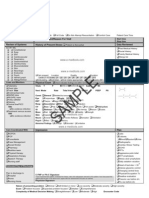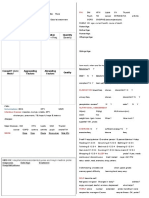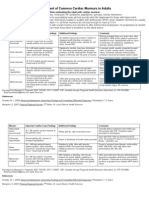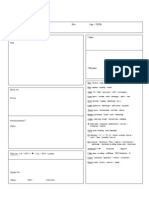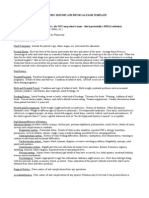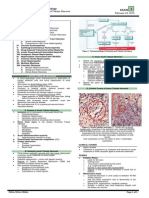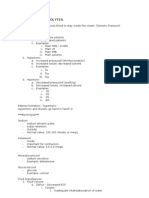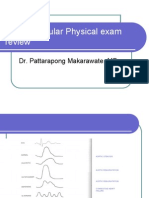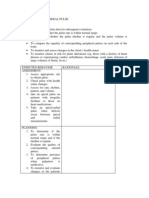Physical Examination Guide
Physical Examination Guide
Uploaded by
Karl Jimenez SeparaCopyright:
Available Formats
Physical Examination Guide
Physical Examination Guide
Uploaded by
Karl Jimenez SeparaCopyright
Available Formats
Share this document
Did you find this document useful?
Is this content inappropriate?
Copyright:
Available Formats
Physical Examination Guide
Physical Examination Guide
Uploaded by
Karl Jimenez SeparaCopyright:
Available Formats
PHYSICAL EXAMINATION GUIDELINE I.
General Information Name of Client: __________________________________________________________ Age: ________ Sex: ________ Unit/Ward: ______________ Bed No.: _________ Examiner: _______________________________________________ Home Addres: ____________________________________________________________________________________ II. Vital Signs and Anthropometric Measurements T: ___________________ oral axillary rectal tympanic BP: __________________ sitting lying standing PR: _______________/min RHYTHM: regular irregular VOLUME: absent thready/weak bounding normal HR: _______________/min regular irregular RR: _______________/min DEPTH: normal deep shallow RHYTHM: regular irregular QUALITY: effortless labored use of acce.muscles WEIGHT: __________kg HEIGHT: __________cm BMI: ______________kg/m2 MUAC: ___________ cm WAIST CIRC: _______cm HIP CIRC: _________cm WAIST-HIP RATIO: _____________ IV. Integument General Color: normal pallor cyanosis jaundice erythema vitiligo Texture: smooth rough others: _____________________ Temperature: warm cool others: ___________________ Turgor: good fair poor Moisture: normal dry wet/clammy oily Lesions: PRIMARY: ecchymosis macule patch papule plaque nodule tumor vesicle bulla pustule cyst wheal SECONDARY: atrophy erosion lichenification scales crust ulcer fissure scar keloid excoriation Edema: pitting non-pitting (GRADING: ____________) VI. Head Configuration: normocephalic smooth contour others: ______________________________________ nodules masses depressions Fontanelles: closed open sunken bulging Facial Features: symmetric slightly symmetric asymmetric exophthalmos moon-faced myxedema Facial movements: symmetric asymmetric involuntary facial movements III. General Survey Build: endomorph mesomorph ectomorph Posture and Gait: relaxed/erect coordinated uncoordinated staggering shuffling stumbling unable to walk alone walks with assistive devices Hygiene: clean/neat unkempt halitosis ( ammoniaodor acetone-odor foul-odor) bromhidrosis Nutrition: well-nourished obese cachexic General Appearance: relaxed signs of distress ( pain, cardio-respiratory anxiety) Emotional State: calm worried restless tense others: ______________________________ Development: well fairly poorly looks accdg to age Looks younger older Level of Consciousness: conscious lethargic obtunded stuporous comatose Coherence: coherent incoherent Orientation: oriented to disoriented to ( time person place) V. Nails Color: pink pallor cyanosis Nail Plate: convex spoon-shaped/koilonychia clubbing Capillary Refill: ______ seconds normal delayed Texture: smooth thick thin beaus lines Inflammation: negative positive (characteristics:____________________________________) Hygiene: clean dirty VII. Neck Trachea: midline deviated to ( right left) Lymph Nodes: nonpalpable palpable enlarged tender Thyroid: nonpalpable enlarged Range of Motion: normal rigid Carotid Pulse: ____________/min symmetric asymmetric RHYTHM: regular irregular VOLUME: absent thready/weak bounding normal NVE: ____________ Masses: present absent Tonic Neck Reflex: present absent
USE TO LOCATE PAIN (red), LESIONS (blue), EDEMA (green)
USE TO GAUGE PAIN
<17 17 18.5 18.5 24.9 25 29.9 >30
BMI Interpretation extremely underweight underweight normal overweight obese (>40 extremely obese)
EDEMA GRADING 1+ = 2mm deep 2+ = 4mm deep 3+ = 6mm deep 4+ = 8mm deep
onchitioss VIII. Eyes Lids: symmetrical asymmetrical edema/swelling (R L) ptosis (R L) Periorbital Region: edema sunken discoloration Eyelashes: equally distributed curled outward turned inward Eyebrows: evenly distributed loss of hair symmetrical asymmetrical skin intact scaling flaking equal movement unequal movement Conjunctiva: pinkish pale red extremely pale extremely red lesion discharge Sclera: anicteric subicteric icteric hemorrhages Lacrimal sac and NL duct: non-tender tender Cornea: transparent shiny smooth arcus senilis (+) sensitivity (-) sensitivity Iris: transparent dicoloration opacity cloudiness Pupils: R:_____mm L:_____mm equal unequal Reaction to Light: R brisk sluggish fixed L brisk sluggish fixed Reaction to Accomodation: equal unequal Peripheral Vision: intact smaller than normal half-vision Extraocular Muscle Test: intact non-intact nystagmus Visual Acuity: grossly normal R:____/____ L:____/____ wears eyeglasses/contact lenses (grade: R:___ L:___) XI. Mouth Lips: pinkish pallor cyanosis dry/crack lesions Mucosa: pinkish pallor cyanosis moist dry lesions Tongue: midline deviated to (R L) atrophy fasciculation lesions Teeth: complete incomplete braces retainers Caries (red), Missing (green), Dentures (blue) Gums: pinkish pale bleeding tender nontender Speech: intact slurred aphasic others: _____________ Gag Reflex: present absent Rooting Reflex: present absent Sucking Reflex: present absent Extrusion Reflex: present absent XII. Chest and Lungs Inspiration:Expiration ratio: ____ : ____ Shape: APL ratio: ____ : ____ barrel funnel pigeon Chest Expansion: symmetrical decreased/lag (R L) Tactile Fremitus: symmetrical decreased or increased @ (R L) lung field Percussion: resonant dull tympanitic hyrresonant Breath Sounds: vesicular over ____________
IX. Ears Auricles: symmetrical asymmetrical aligned with outer canthus of the eye low-set ears Color: same as facial skin pallor cyanosis Texture/Elasticity/Tenderness: mobile firm non-tender tender pinna recoils after folded Gross Abnormalities: _________________________________ External Canal/Middle Ear: impacted cerumen discharge ( foul smelling serous purulent mucoid) Gross Hearing: symmetrical deafness (R L) with hearing devices: ___________________________ Rinnes Test: R ______ L ______ Webers Test: lateralization (R L) Startle reflex: present absent X. Nose Nasolabial Fold: symmetrical shallow (R L) Septum: midline deviated (R L) perforated Mucosa: pinkish pallor cyanosis redness discharge ( bloody serous purulent mucoid) Patency: both patent obtructed (R L) Masses/Lesions Sinuses: tender non-tender Gross Smelling: symmetrical olfactory deficiency (R L) bronchovesicular over ____________ bronchial over _____________ Adventitious Breath Sound: absent fine crackles coarse crackles wheezes rhonchi stridor friction rub Sound Vesicular Bronchovesicular Bronchial Fine Crackles* Character Insp. > Exp. Insp. = Exp. Exp. > Insp. Soft, highpitched (510msec) Coarse Crackles* Louder, lower in pitch (2030msec) Wheezes High-pitched; have hissing or shrill quality Rhonchi Low-pitched; have a snoring quality * crackles is sometimes called rales Indication Normal Normal Normal Pneumonia, fibrosis, early CHF, bronchitis, bronchiectasis Narrowed airways as in asthma, COPD, bronchitis Secretions in large airways
Primary Skin Lesions: Macule: flat, 1mm to 1cm Patch: flat, >1 cm Papule: circumscribed, elevated, <1cm Plaque: elevated, >1cm Nodule: elevated, deeper than papule, 0.5 2cm Tumor: elevated, deeper, may be irregular in shape, >2cm Vesicle: circumscribed, with serous fluid, <0.5cm Bulla: circumscribed, with serous fluid, >0.5cm Pustule: vesicle o bulla filled with pus Cyst: >1cm, fluid-filled, deeper than vesicle and bulla Wheal: reddened, irregular in shape Secondary Skin Lesions: Atrophy: dry, paperlike, wrinkled skin surface Erosion: moist, shallow depression, epidermis only Lichenification: rough, thickened, hardened area Scales: shedding flakes of greasy, keratinized tissue Crust: dry blood, serum, or pus left on the surface Ulcer: deep, irregularly-shaped, extending to dermis or subQ Fissure: linear crack with sharp edges Scar: flat, irregular area of connective tissue after wound healing Keloid: elevated, irregular, darkened area of excess scar tissue Excoriation: linear erosion
USE TO LOCATE CARIES (red), MISSING TEETH (green), DENTURES (blue)
onchitioss XIII. Heart Precordial Area: flat bulging normodynamic hyperdynamic tenderness PMI at ____________________________________ pulsation displaced ( laterally lower) heave thrill Aortic area at _______________________________________ pulsation heave thrill Pulmonic area at _____________________________________ pulsation heave thrill Tricuspid area at _____________________________________ pulsation heave thrill Apical area at _______________________________________ pulsation heave thrill Heart Sounds: distinct faint S1 _____ S2 at base S1 _____ S2 at apex Extra heart sounds: S3 S4 Murmurs: absent present (GRADE: _________) Best heard at ____________________________________ Jugular Vein: not visible distended Jugular Venous Pressure*: ____cm elevated not elevated XV. Abdomen Appearance: uniform color striae lesions purple striae tense, glistening skin (for ascites) dilated veins Configuration/Contour: flat globular protuberant scaphoid symmetrical asymmetrical Abdominal Movement: symmetrical asymmetrical peristalsis aortic pulsations Umbilicus: sunken bulging hernia Bowel Sounds: ________/min normoactive hyperactive hypoactive absent Arterial Bruit: absent present ( aortic iliac renal artery) Friction Rub: absent present Percussion: Tympanitic at _____________________________ Dull at ___________________________________ Fluid Wave: absent present Shifting Dullness: absent present Liver: non-palpable enlarged smooth border nodular hard tender non-tender Spleen: non-palpable enlarged tender non-tender Bladder: non-palpable distended Others: muscle guarding direct tenderness rebound tenderness masses: _____________________________ CVA: tender non-tender
XIV. Breast and Axillae Size: symmetrical asymmetrical Appearance: same as color of abdomen or back discoloration striae dimpling/retraction hypervascularization swelling edema Areola: round oval symmetrical asymmetrical Nipples: round everted inverted symmetrical size asymmetreical size discharge: ___________________ Lymph Nodes: palpable non-palpable Breast tissue: non-tender tender masses nodules discharge: ____________________________________ XVI. Ano-Genital FEMALE: Pubic Hair: kinky inverse triangle scant extended to abdomen parasites lesions Labia: symmetrical asymmetrical pinkish discoloration Orifice: same color as surrounding tissue discoloration inflammation swelling discharge lesions Clitoris: _______cm MALE: Pubic Hair: triangular distribution extending to abdomen scant absent others: ________________________ Penis: intact skin slightly wrinkled wrinkled smegma swelling inflammation nodules lesions tenderness immobility smooth/semifirm Meatus: pinkish discoloration discharge:______________ Scrotum: symmetrical asymmetrical marked asymmetry discoloration tightening of skin darker in color enlarged nodules lesions non-tender tender BOTH: Lymph Nodes: non-palpable swelling non-tender tender Femoral Hernia: absent present Inguinal Hernia: absent present Anus: intact skin lesions tender non-tender RectalWall: smooth non-tender tender nodular lesions XVII. Back and Extremities Spine: straight curved kyphosis scoliosis lordosis Joints: non-tender tender redness warm swelling crepitation nodules ROM: move smoothly full decresed at _______________ Muscles: equal in size unequal in size atrophy contractures tremors firm/tonic atonic foot drop Movement: smooth coordinated flaccid spastic Stength: equal unequal (GRADE: __________________)
Grading Muscle Strength: 0 0% of normal strength; complete paralysis 1 10% of normal strength; no movement, contraction of muscle is palpable and visible 2 25% of normal strength; full muscle movement against gravity, with support 3 50% of normal strength; normal movement against gravity 4 75% of normal strength; normal full movement against gravity and against minimal resistance 5 100% of normal strength; normal full movement against gravity and against full resistance
Grading Murmur: 1 Very faint; heard during valsalva maneuver 2 Quiet 3 Moderately loud 4 Loud with palpable thrill 5 Very loud with thrill; with stethoscope 6 Very loud with thrill; without stethoscope USE TO LOCATE ABDOMINAL LESIONS (scars, rashes, etc.)
You might also like
- Coovadias Paediatrics and Child Health 7eDocument1,170 pagesCoovadias Paediatrics and Child Health 7eCuthbert Tinotenda Musarurwa90% (10)
- EMR Documentation TemplatesDocument25 pagesEMR Documentation TemplatesFlint Ray100% (2)
- Neonatal and Pediatric VesselsDocument6 pagesNeonatal and Pediatric VesselsAhmed Gaber100% (1)
- OB History Taking ChecklistDocument12 pagesOB History Taking Checklist2140916No ratings yet
- Medical Terminolog1Document25 pagesMedical Terminolog1Jullia SollezaNo ratings yet
- 2016 CPG Ent PDFDocument21 pages2016 CPG Ent PDFCamelle CelisNo ratings yet
- Patient Information FormDocument6 pagesPatient Information FormKimCriglerNo ratings yet
- H&P OutlineDocument5 pagesH&P Outlineginadaislu100% (1)
- Hospital Follow Up Progress Note MedicalTemplateDocument1 pageHospital Follow Up Progress Note MedicalTemplatee-MedTools100% (18)
- Medicine Cheat SheetsDocument16 pagesMedicine Cheat SheetsRisa Muthmainah100% (1)
- New Patient History FormDocument6 pagesNew Patient History Formعبدالله الكافNo ratings yet
- CARAS SCUTSHEET 2nd EditDocument2 pagesCARAS SCUTSHEET 2nd EditFrances Katrina Siruno100% (2)
- CVS-01 Examination & Short CasesDocument9 pagesCVS-01 Examination & Short Casesem khanNo ratings yet
- Vital Signs ProcedureDocument10 pagesVital Signs ProcedureJojebelle Kate Iyog-cabanlet100% (3)
- (3F) Pediatrics - Pediatric HistoryDocument9 pages(3F) Pediatrics - Pediatric HistoryNomar Nonato100% (3)
- PT Admission FormDocument1 pagePT Admission FormAjith KumarNo ratings yet
- Pre-Hospital Assessment Sheet: Triage ScoreDocument2 pagesPre-Hospital Assessment Sheet: Triage Scoreratna purwitasariNo ratings yet
- Comprehensive Adult Health HistoryDocument7 pagesComprehensive Adult Health HistoryKhirsna PasajolNo ratings yet
- History and Physical ExaminationDocument4 pagesHistory and Physical ExaminationVernonDimalNo ratings yet
- Patient History TemplateDocument2 pagesPatient History TemplateDr Shazana NazrinNo ratings yet
- Cardiac MurmursDocument3 pagesCardiac MurmursDanielleNo ratings yet
- New Patient AdmitDocument2 pagesNew Patient AdmitNetradeep Narayansa DagduNo ratings yet
- Health HistoryDocument19 pagesHealth HistoryAngelene Caliva100% (1)
- H&PEDocument2 pagesH&PEDanielleNo ratings yet
- Clinical Health RequirementsDocument6 pagesClinical Health RequirementsbarneylovesbagelsNo ratings yet
- Examination of ChestDocument24 pagesExamination of ChestNayan MaharjanNo ratings yet
- Med History & PE GuideDocument7 pagesMed History & PE GuideStephanie GaerlanNo ratings yet
- Guide To The Comprehensive, Adult Write-UpDocument6 pagesGuide To The Comprehensive, Adult Write-UpKeaira Kc100% (1)
- History & Physical Diagnostic#Document106 pagesHistory & Physical Diagnostic#Olsa Alshapira100% (1)
- Head To Toe Checklist (Masroni)Document13 pagesHead To Toe Checklist (Masroni)hillary elsaNo ratings yet
- Medical MnemonicsDocument107 pagesMedical MnemonicsdrabuelaNo ratings yet
- SOAP TemplateDocument3 pagesSOAP Templateazhar100% (1)
- Oncologic EmergenciesDocument3 pagesOncologic EmergenciesMiguel Cuevas DolotNo ratings yet
- Mbbs Crri Orientation-25072017Document451 pagesMbbs Crri Orientation-25072017rajaeasNo ratings yet
- Assessment of The Chest and Lungs: Pat Jackson AllenDocument50 pagesAssessment of The Chest and Lungs: Pat Jackson Allenbuzz Q100% (3)
- History Taking ChecklistDocument4 pagesHistory Taking Checklistalnoooor38100% (1)
- Head To Toe Assessment GuideDocument2 pagesHead To Toe Assessment GuideSara SabraNo ratings yet
- 2010 GYN ModuleDocument36 pages2010 GYN Modulelolapell100% (1)
- Fullsize SBAR Report SheetDocument2 pagesFullsize SBAR Report SheetMeg AqNo ratings yet
- New Assessment Form 2Document5 pagesNew Assessment Form 2api-3739910100% (2)
- OPD Adolescent History FormDocument5 pagesOPD Adolescent History FormNehemiah FranciscoNo ratings yet
- Rapid History Taking: 1. Patient ProfileDocument3 pagesRapid History Taking: 1. Patient ProfileTunio Usama100% (1)
- University of Santo Tomas Faculty of Medicine & Surgery Department of Medicine Medicine 1 Cardiovascular Examination ChecklistDocument4 pagesUniversity of Santo Tomas Faculty of Medicine & Surgery Department of Medicine Medicine 1 Cardiovascular Examination ChecklistSocorro DuqueNo ratings yet
- SOAP Presentation 5.19.16 PDFDocument1 pageSOAP Presentation 5.19.16 PDFnems92No ratings yet
- SOAP Note Template With ExampleDocument9 pagesSOAP Note Template With ExampleHazelina VillamorNo ratings yet
- Handp TemplateDocument3 pagesHandp TemplateLauren GrandpreNo ratings yet
- Clinical Examination Sheet (General Examination)Document3 pagesClinical Examination Sheet (General Examination)Yara WaelNo ratings yet
- Soap Note Template 03Document5 pagesSoap Note Template 03Razan HaimounyNo ratings yet
- Surg 5s 2 History Taking Physical Examination RevisedDocument17 pagesSurg 5s 2 History Taking Physical Examination RevisedSheena PasionNo ratings yet
- Conduct of Physical Examination: I. General SurveyDocument10 pagesConduct of Physical Examination: I. General SurveyWeng RamojalNo ratings yet
- How Do I Diagnose The Cause of A Cough of Less Than 3 Weeks' Duration?Document14 pagesHow Do I Diagnose The Cause of A Cough of Less Than 3 Weeks' Duration?Sudhir TyagiNo ratings yet
- H P MedicineDocument2 pagesH P Medicinerishu2No ratings yet
- Complete ROS and PEDocument6 pagesComplete ROS and PEJulienneNo ratings yet
- Trauma SheetDocument1 pageTrauma SheetbrownehsNo ratings yet
- Medical History FormDocument2 pagesMedical History Formapi-279870303No ratings yet
- History and Physical Exam Skills List: Opening VisitDocument7 pagesHistory and Physical Exam Skills List: Opening VisitAnonymous Sfcml4GvZNo ratings yet
- DM CaseDocument11 pagesDM Casesaina100% (1)
- BATES Peripheral Vascular SystemDocument2 pagesBATES Peripheral Vascular SystemAngelica Mae Dela CruzNo ratings yet
- Diabetes EvaluationDocument3 pagesDiabetes Evaluatione-MedTools100% (3)
- Jim's Surgery Progress Note TemplateDocument1 pageJim's Surgery Progress Note TemplatekatNo ratings yet
- Cinical Note Sheet: Prsenting ComplaintsDocument2 pagesCinical Note Sheet: Prsenting ComplaintsDhananjay SainiNo ratings yet
- Medical Review of Systems: General, Constitutional Heart and Cardiovascular Hematologic/LymphaticDocument1 pageMedical Review of Systems: General, Constitutional Heart and Cardiovascular Hematologic/LymphaticBola S-SNo ratings yet
- Cerebrovascular Accident (Cva) : DescriptionDocument12 pagesCerebrovascular Accident (Cva) : DescriptionAbeera AhmadNo ratings yet
- Niversity of The Philippines Manila: Nursing Health History Date of Interview: (Input) A. Biographic DataDocument4 pagesNiversity of The Philippines Manila: Nursing Health History Date of Interview: (Input) A. Biographic DataConstance Isabelle MercadoNo ratings yet
- Physical Assessment FormDocument6 pagesPhysical Assessment Formnorhain4.aNo ratings yet
- 2011 Dec MCQDocument12 pages2011 Dec MCQKarl Jimenez SeparaNo ratings yet
- 2011 Dec MCQDocument12 pages2011 Dec MCQKarl Jimenez SeparaNo ratings yet
- 2010 Dec MCQDocument12 pages2010 Dec MCQKarl Jimenez SeparaNo ratings yet
- 2011 Aug MCQ PDFDocument14 pages2011 Aug MCQ PDFKarl Jimenez SeparaNo ratings yet
- Pathogenesis of Split-Hand/split-Foot Malformation: Pascal H.G. Duijf, Hans Van Bokhoven and Han G. BrunnerDocument10 pagesPathogenesis of Split-Hand/split-Foot Malformation: Pascal H.G. Duijf, Hans Van Bokhoven and Han G. BrunnerKarl Jimenez SeparaNo ratings yet
- 2014 CONTINUUM Neurologic Complications of Illicit Drug AbuseDocument15 pages2014 CONTINUUM Neurologic Complications of Illicit Drug AbuseKarl Jimenez SeparaNo ratings yet
- INTERNS NOTES - OtorhinolaryngologyDocument15 pagesINTERNS NOTES - OtorhinolaryngologyKarl Jimenez SeparaNo ratings yet
- Bacterial Men CPGDocument42 pagesBacterial Men CPGKarl Jimenez SeparaNo ratings yet
- CPG Abnormal Labor and Delivery PDFDocument29 pagesCPG Abnormal Labor and Delivery PDFKarl Jimenez Separa100% (2)
- Uhhq7Hd'Ulqnlqj+Delwvdqg Dvwulf&Dqfhulq6Rxwkzhvw China: Research CommunicationDocument4 pagesUhhq7Hd'Ulqnlqj+Delwvdqg Dvwulf&Dqfhulq6Rxwkzhvw China: Research CommunicationKarl Jimenez SeparaNo ratings yet
- CML DiagnosisDocument4 pagesCML DiagnosisKarl Jimenez SeparaNo ratings yet
- Duty Schedule For Mess HallDocument4 pagesDuty Schedule For Mess HallKarl Jimenez SeparaNo ratings yet
- Exam OS 214: Nephrology: Lec 08: Pathology of Tubular DiseasesDocument5 pagesExam OS 214: Nephrology: Lec 08: Pathology of Tubular DiseasesKarl Jimenez SeparaNo ratings yet
- 2 Handout 2 Physical Examination FINAL FINALDocument25 pages2 Handout 2 Physical Examination FINAL FINALGloriana Julia TeopeNo ratings yet
- Simulator PDFDocument16 pagesSimulator PDFsssadangiNo ratings yet
- Guidelines For The Management of Congenital Heart Diseases in CH 2017Document105 pagesGuidelines For The Management of Congenital Heart Diseases in CH 2017Ludwig CaceresNo ratings yet
- Krok 2 Paper 4Document6 pagesKrok 2 Paper 4berdaderagaNo ratings yet
- Cardiology Quick Revision Final 3Document215 pagesCardiology Quick Revision Final 3bsjdbd dbNo ratings yet
- History Taking and Ce of Cardiac PatientsDocument89 pagesHistory Taking and Ce of Cardiac Patientsapi-3858544100% (1)
- BBS - Finals Compilation - Project Coffee PDFDocument318 pagesBBS - Finals Compilation - Project Coffee PDFNoel JoaquinNo ratings yet
- Fluid and ElectrolytesDocument60 pagesFluid and ElectrolytesAlgene AnnNo ratings yet
- พี่พงษ์ติวcardioDocument79 pagesพี่พงษ์ติวcardioRapid Medicine67% (3)
- Chapter 11 - Cardiovascular SystemDocument10 pagesChapter 11 - Cardiovascular SystemrishellemaepilonesNo ratings yet
- Cardio WorkbookDocument21 pagesCardio WorkbookMedStudent MedStudentNo ratings yet
- Nursing Care Plan WeeblyDocument8 pagesNursing Care Plan Weeblyapi-277498943No ratings yet
- Med CvsDocument29 pagesMed CvsPrakruti VaghaniNo ratings yet
- Clinical QuidDocument175 pagesClinical QuidHassan Al SinanNo ratings yet
- Cardiac NursingDocument26 pagesCardiac Nursingjgcriste95% (20)
- Anatomy and Cardiovascular AssessmentDocument52 pagesAnatomy and Cardiovascular AssessmentNaomi Anne AsuntoNo ratings yet
- Cardiovascular ExaminationDocument13 pagesCardiovascular ExaminationBitu JaaNo ratings yet
- Cardiovascular Nursing NotesDocument17 pagesCardiovascular Nursing NotesLucky Gomez100% (1)
- Acute Leukemia: Heart (Myocardial) InfarctionDocument4 pagesAcute Leukemia: Heart (Myocardial) InfarctionSisham SubediNo ratings yet
- Abbreviations List PDFDocument38 pagesAbbreviations List PDFadila sayangNo ratings yet
- Tom Sult - Book ExcerptDocument57 pagesTom Sult - Book Excerptdayonara2003No ratings yet
- Assessing A Peripheral PulseDocument5 pagesAssessing A Peripheral Pulsecrrfrnc0% (1)
- Physical Assessment Exam Study GuideDocument55 pagesPhysical Assessment Exam Study GuideApRil Anne Balanon100% (1)
- Physiology OSPEDocument18 pagesPhysiology OSPEminareeba57No ratings yet
- Cmca Rle 13Document126 pagesCmca Rle 13Carl Josef C. GarciaNo ratings yet








